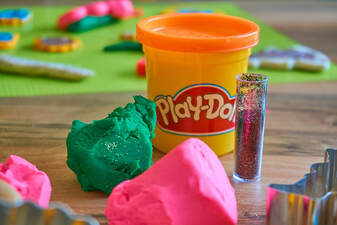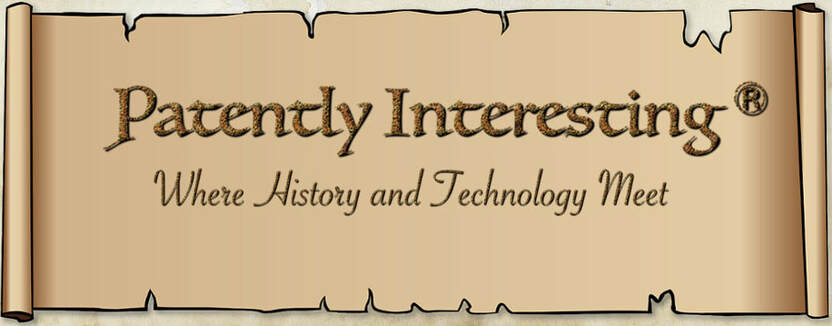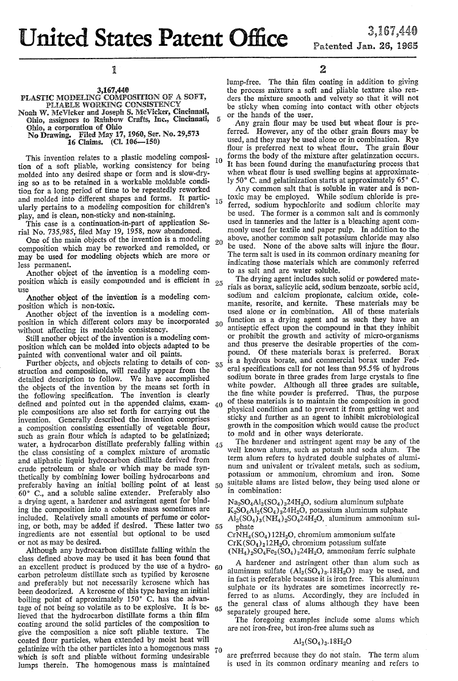
On January 26, 1965, U.S. Patent No.: 3,167,440 issued to Noah W. McVicker and Joseph S. McVicker for "Plastic Modeling Composition of a Soft, Pliable Working Consistency". The composition covered by the '440 patent is better known by its trademark, Play Doh®.
Originally, the Play Doh® composition was formulated by Noah McVicker of the Kutol Products Company in the 1930's to clean soot from wallpaper. The soot came from coal furnaces, which were popular at the time. The cleaner worked well and soon became the largest selling wallpaper cleaner in the world. Times changed, however, and coal furnaces became less common. In addition, vinyl wallpaper, which was washable, appeared on the market. These two developments combined to destroy the market for the Kutol cleaner by the mid-1950's.
Just as Kutol Products was about to stop manufacturing its cleaner, Joe McVicker, who was the head of Kutol Products at the time, received a suggestion from his sister-in-law, Kay Zufall, that completely changed everything. Kay was an elementary school teacher who read a newspaper article about using the Kutol cleaner as modeling clay for children. Obtaining one of the last cans of the Kutol cleaner, Kay experimented with the composition and found that her students loved playing with it. She convinced Joe to change the composition of the Kutol cleaner and market it as children's modeling clay. Joe agreed and, together with his uncle, Noah, reformulated the composition by removing the detergent and adding an almond scent.
Joe and Noah started selling their new modeling clay in the Cincinnati area in 1955 under the trademark Play Doh®, which was also suggested by Kay. They later formed a new company, Rainbow Crafts, Inc., to market and sell the Play Doh® modeling clay. After Joe convinced the TV personality Captain Kangaroo to endorse the Play Doh® modeling clay on his television show, sales of Play Doh® modeling clay took off and became wildly popular.
Joe and Noah originally filed a patent application for their modeling clay on May 19, 1958, but it took them seven years and the filing of a continuing application in 1960 to finally obtain the '440 patent. The composition that was claimed in the '440 patent consisted essentially of grain flour, water, kerosene and a non-toxic inorganic chlorine salt, such as table salt (NaCl). The kerosene is the most interesting component of the patented formulation and has most likely been replaced with a less flammable component like mineral oil or vegetable oil.
Originally, the Play Doh® composition was formulated by Noah McVicker of the Kutol Products Company in the 1930's to clean soot from wallpaper. The soot came from coal furnaces, which were popular at the time. The cleaner worked well and soon became the largest selling wallpaper cleaner in the world. Times changed, however, and coal furnaces became less common. In addition, vinyl wallpaper, which was washable, appeared on the market. These two developments combined to destroy the market for the Kutol cleaner by the mid-1950's.
Just as Kutol Products was about to stop manufacturing its cleaner, Joe McVicker, who was the head of Kutol Products at the time, received a suggestion from his sister-in-law, Kay Zufall, that completely changed everything. Kay was an elementary school teacher who read a newspaper article about using the Kutol cleaner as modeling clay for children. Obtaining one of the last cans of the Kutol cleaner, Kay experimented with the composition and found that her students loved playing with it. She convinced Joe to change the composition of the Kutol cleaner and market it as children's modeling clay. Joe agreed and, together with his uncle, Noah, reformulated the composition by removing the detergent and adding an almond scent.
Joe and Noah started selling their new modeling clay in the Cincinnati area in 1955 under the trademark Play Doh®, which was also suggested by Kay. They later formed a new company, Rainbow Crafts, Inc., to market and sell the Play Doh® modeling clay. After Joe convinced the TV personality Captain Kangaroo to endorse the Play Doh® modeling clay on his television show, sales of Play Doh® modeling clay took off and became wildly popular.
Joe and Noah originally filed a patent application for their modeling clay on May 19, 1958, but it took them seven years and the filing of a continuing application in 1960 to finally obtain the '440 patent. The composition that was claimed in the '440 patent consisted essentially of grain flour, water, kerosene and a non-toxic inorganic chlorine salt, such as table salt (NaCl). The kerosene is the most interesting component of the patented formulation and has most likely been replaced with a less flammable component like mineral oil or vegetable oil.


